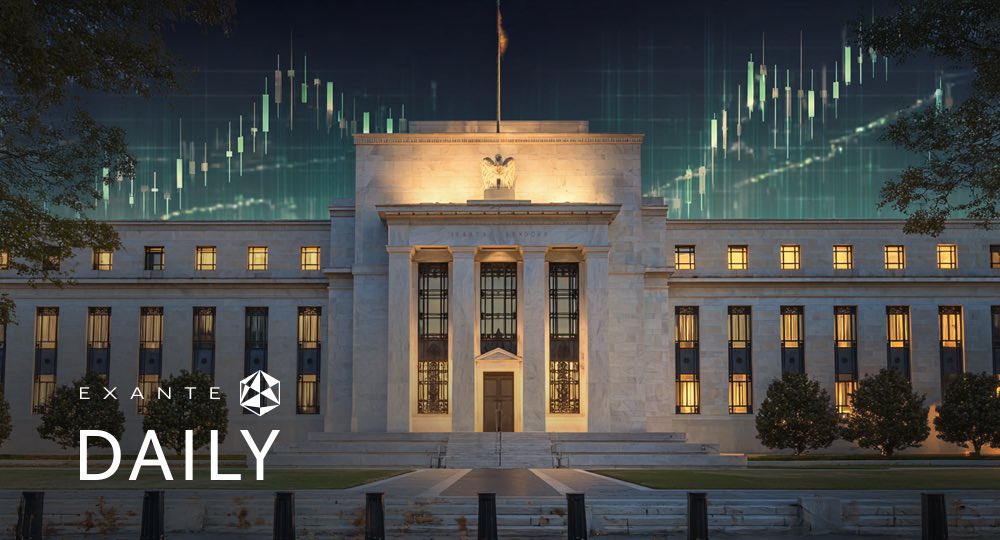
Are markets too relaxed about oil?

Corporate Earnings News
Global market indices
Currencies
Cryptocurrencies
Fixed Income
Commodity sector news
Key data to move markets
Global macro updates
Corporate Earnings News
Corporate earning calendar 16 October-23 October 2024
Thursday: Blackstone, MorganStanley, Taiwan Semiconductor Manufacturing, Intuitive Surgical, Netflix, Marsh & McLennan Cos. Inc.
Friday: American Express, SLB, Procter & Gamble
Monday: Nucor, SAP
Tuesday: 3M Company, Baker Hughes, Danaher, Freeport-McMoRan, GE Aerospace, General Motors, Kimberly-Clark Corporation, Lockheed Martin, Philip Morris International, The Sherwin-Williams Company, Southern Copper Corp., Teladoc, Verizon
Wednesday: Tesla, AT&T, Boston Scientific Corp., Coca-Cola, CME Group, Boeing, General Dynamics, GE Vernova, Thermo Fisher Scientific, International Business Machines (IBM), Newmont, QuantumScape, ServiceNow, T-Mobile US
Global market indices
US Stock Indices Price Performance
Nasdaq 100 +0.49% MTD +19.81% YTD
Dow Jones Industrial Average +0.97% MTD +13.40% YTD
NYSE +1.58% MTD +17.64% YTD
S&P 500 +1.39% MTD +22.49% YTD
The S&P 500 is +0.87% over the past week, with 7 of the 11 sectors up MTD. The Equally Weighted version of the S&P 500 posted a +1.52% gain this week, its performance is +1.26% MTD and +14.97% YTD.
The S&P 500 Financials sector is the leading sector so far this month, up +4.67% MTD and +26.03% YTD, while Consumer Discretionary is the weakest at -1.05% MTD +12.02% YTD.
This week, Utilities outperformed within the S&P 500 at +4.41%, followed by Financials and Real Estate at +3.73% and +3.12%, respectively. Conversely, Energy underperformed at -1.47%, followed by Health Care and Information Technology , -0.09% and -0.04%, respectively.
The S&P 500 advanced on Wednesday, propelled by gains in the banking and airline sectors, even as many large technology stocks experienced a pullback. Economically sensitive shares outperformed, with the Russell 2000 of smaller firms hitting the highest in almost three years. The S&P 500 was +0.5%, while the Dow Jones Industrial Average climbed +0.8%, or approximately 337 points, to reach a new record closing high of 43,077.70. The Nasdaq Composite also registered a gain of +0.3%.
Bank stocks surged on evidence of increasing momentum in dealmaking and trading activity on Wall Street. Morgan Stanley shares jumped by +6.5% after the bank reported a 56% surge in investment-banking revenue. Citigroup and Bank of America also saw their shares rise, gaining +2.6% and +1.6%, respectively.
Airline stocks rallied following United Airlines' announcement of better-than-expected quarterly profits and its indication that the oversupply of cheap flights had subsided. United Airlines shares soared by +12% to close at $72.02, their highest closing price since February 2020. Delta Air Lines and American Airlines shares also experienced significant gains, rising by +6.8% and +7.1%, respectively.
The S&P 500 has already achieved 46 record closing highs this year. Historical data dating back to 1928 indicates that the median return for the S&P 500 from 15th October to 31st December is +5.17%. In election years, this median return is even higher, exceeding +7%.
In corporate news, Uber Technologies is reportedly exploring a potential bid for Expedia, although the process is in its very early stages, and no active discussions are currently underway.
Amazon has announced plans to invest over $500 million in the development of small, modular nuclear reactors.
General Motors is investing $625 million in a joint venture focused on lithium production in the United States.
Bullish sentiment improves as investors eye post-election market dynamics. The latest US Investor's Intelligence poll, for the week ending 15th October, revealed a notable increase in bullish sentiment among investors. The percentage of bulls rose to 57.6%, up from 53.2% the previous week, marking the highest reading since late July. During that period, bullish sentiment exceeded 60% for seven consecutive weeks, a level the report identifies as a ‘high-risk danger zone.’
Conversely, the percentage of bears decreased to 22.0% from 22.6%, resulting in a widening of the bull-bear spread to +35.6% from +30.6%. This represents a nearly 15 percentage point increase from the +20.9% spread observed five weeks ago, which was the narrowest since the fall of 2023 when markets faced significant pressure.
This surge in optimism aligns with the findings of the October BofA Global Fund Manager Survey, which reported the most significant jump in investor confidence in four years.
Several factors contribute to this positive sentiment, including increasing acceptance of the ‘soft landing’ or ‘no landing’ economic narrative and the anticipation of a Fed easing cycle driven by disinflation. Other prominent bullish talking points include expectations of an unwinding of crowded downside hedges following the upcoming election (a development that could counteract concerns about overextended sentiment and positioning), the imminent reopening of corporate buyback windows (with Goldman Sachs projecting $6 billion per day in buybacks through year-end), favourable late-year seasonality, and relatively low expectations for upcoming Q3 earnings.
US stocks
Mega caps: A mixed week for the ‘Magnificent Seven’ due to a presentation by Tesla on Thursday that was expected to lay out Tesla’s transformation into a robotics and AI powerhouse and instead disappointed investors. Alphabet +2.04%, Amazon +0.93%, Apple +0.98%, Meta Platforms -2.32%, Microsoft -0.32%, Nvidia +2.31%, and Tesla -8.18%.
Energy stocks had a negative week, as the Energy sector itself was -1.47% due to easing concerns on potential supply disruption caused by escalating geopolitical conflicts in the Middle East and uncertainty about future Chinese demand. The sector’s YTD performance is +8.54%. Over the week Apa Corp (US) -5.81%, ConocoPhillips -5.24%, Occidental Petroleum -4.90%, Halliburton -3.49%, Marathon Petroleum -2.90%, Baker Hughes -2.26%, Shell -2.07%, Phillips 66 -1.79%, ExxonMobil -1.17%, and Chevron -0.69%, while Energy Fuels +21.83%.
Materials and Mining stocks had a positive week, as the Materials sector was +2.25%, bringing the sector’s YTD performance to +13.67%. Newmont Corporation +6.71%, Mosaic +3.13%, Nucor +1.61%, and Yara International +0.43%, while Freeport-McMoRan -1.84%, CF Industries -3.28%, Albemarle -3.60%, and Sibanye Stillwater -8.91%.
Newmont announced on Wednesday that it is partnering with MKS PAMP to offer consumers a traceable gold bar exclusively made with Newmont-mined gold, refined and minted by MKS PAMP in Switzerland. The mine-to-market traceable PAMP 1oz Lady of Liberty gold bar will be available to US consumers. Newmont claims the traceable 1oz Lady of Liberty gold bar will give consumers greater assurance into the origin of their gold.
European Stock Indices Price Performance
Stoxx 600 -0.63% MTD +8.48% YTD
DAX +0.56% MTD +16.01% YTD
CAC 40 -1.88% MTD -0.68% YTD
IBEX 35 +1.01% MTD +18.75% YTD
FTSE MIB +1.57% MTD +14.19% YTD
FTSE 100 +1.12% MTD +7.70% YTD
This week, the pan-European Stoxx Europe 600 index was -0.09%, closing at 519.60. It was -0.19% on Wednesday.
In the STOXX Europe 600, Telecom is the leading sector so far this month, up +3.84% MTD and +20.59% YTD, while Technology is the weakest at -6.30% MTD +1.77% YTD.
This week Telecom outperformed within the STOXX Europe 600 with a +3.44% gain, followed by Utilities and Retail at +3.42% and +3.00%, respectively. Conversely, Technology underperformed at -6.65 %, followed by Personal and Household Goods and Oil & Gas, -2.58% and -2.34%, respectively.
Germany's DAX index was -0.27 % on Wednesday and closed at 19,432.81. It was +0.92% for the week. France's CAC 40 index was -0.40% on Wednesday, closing at 7,492.00. It was -0.90% for the week.
The UK's FTSE 100 index was +1.04% this week to 8,329.07. It was +0.97% on Wednesday.
Other Global Stock Indices Price Performance
MSCI World Index +0.33% MTD +17.86% YTD
Hang Seng -4.01% MTD +19.00% YTD
This week, the Hang Seng Index was -1.70% due to falling investor confidence following recent stimulus measures from China which overshadowed increasing expectations for a soft or no landing scenario in the US and steady rate cuts by the US Federal Reserve. The MSCI World Index was +0.51% this week.
Currencies
EUR -2.44% MTD -1.57% YTD to $1.0864
GBP -2.84% MTD +2.07% YTD to $1.2985
The euro was -0.70% against the USD over the past week, while the British pound was -0.57%. The Dollar Index was +0.57% this week, +2.72% MTD, and +2.16% YTD.
The US dollar firmed on Wednesday, hitting an 11-week high, as investors ruled out a hefty interest rate cut from the Fed at the next policy meeting.
Sterling tumbled to its lowest in two months after softer-than-expected British inflation data offered scope for the BoE to cut rates more forcefully, while the euro slid to an 11-week low ahead of today’s ECB meeting. Consumer-price growth moderated to 1.7% in September from 2.2% the previous month, Eurostat reported today. The initial estimate was 1.8%. This is raising hopes of two back-to-back cuts by the ECB.
The dollar index ultimately closed +0.25% on the day, at 103.52, after hitting an 11-week high of 103.60. The euro fell -0.28% against the dollar to $1.0858, after earlier sliding to $1.0853, its lowest since early August. Conversely, the euro was +0.36% against Sterling, settling at 0.8361 pence.
The British pound experienced a significant decline, falling by -0.61% to $1.2985 against the US dollar. This drop pushed the pound below the $1.30 level for the first time since 20th August, following the release of data showing a decrease in the annual consumer price inflation rate to 1.7% in September, down from 2.2% in August. This marks the lowest inflation reading since April 2021.
In contrast, the US dollar strengthened against the Japanese yen, rising by +0.23% to reach ¥149.57. This level remains close to Monday's high of ¥149.98, which was the strongest level for the dollar against the yen since 1st August.
BoJ board member Seiji Adachi emphasised the need for a cautious approach to monetary policy. On Wednesday, Adachi stated that the central bank must raise interest rates at a "very moderate" pace, avoiding premature hikes due to uncertainties surrounding the global economic outlook and domestic wage developments.
Note: As of 5:30 pm EDT 16 October 2024
Cryptocurrencies
Bitcoin +6.96% MTD +60.98% YTD to $67,596
Ethereum +6.85% MTD +13.90% YTD to $2,615.20
It was a positive week for the two major cryptocurrencies. Bitcoin rose +11.44% over the week, while Ethereum was +10.48%.
Although Fed policymakers have suggested that future rate cuts will be at a more moderate pace, the value of cryptocurrencies has continued to rise over the past week and month. According to data from CryptoQuant, the open interest of Bitcoin hit an all-time high of $19.8 billion on 15 October and funding rates have attained their highest positive level since August, suggesting that these are likely long positions expecting further appreciation. In addition, there appears to be increased interest from investors in cryptocurrency Spot ETFs. According to Spot Bitcoin ETF tracker Farside, the 11 Spot Bitcoin ETFs recorded aggregate net inflows of $555.9 million on 14 October, the largest daily inflow since June. And in another positive sign for the cryptocurrency sector, a study published Wednesday by a16z crypto, owned by investment firm Andreessen Horowitz, found crypto activity and usage are at an all-time high this year. The report estimated around 617 million global cryptocurrency owners, with up to 60 million monthly active users, as of September.
Note: As of 5:30 pm EDT 16 October 2024
Fixed Income
US 10-year yield +26.4 bps MTD +13.7 bps YTD to 4.018%.
German 10-year yield +5.2 bps MTD +17.8 bps YTD to 2.187%.
UK 10-year yield +8.9 bps MTD +52.9 bps YTD to 4.068%.
US Treasury 10-year bond yields are -4.7 basis points (bps) this week.
US Treasury yields declined on Wednesday, with the 10-year yield experiencing its third consecutive daily decrease. This decline comes as investors adjust their interest rate expectations in anticipation of forthcoming data on consumer spending.
The 10-year yield had previously seen four consecutive weeks of growth, reaching 4.12% last week, a peak not observed since 31st July.
Data released on Wednesday by the Labor Department revealed a -0.4% decrease in import prices last month, marking the most substantial decline since December 2023. This follows a revised -0.2% dip in August and is attributed to a significant reduction in energy product costs. The data suggests a moderate inflationary environment, reinforcing the Fed's trajectory of continued interest rate reductions.
Market participants await Thursday's retail sales figures, which will offer insights into the health of the consumer sector.
Current market projections, as indicated by CME's FedWatch Tool, suggest a 92.2% probability of a 25 bps rate cut at the upcoming FOMC meeting. The likelihood of the central bank maintaining its current rate is 7.8%. Expectations for a 50 bps rate cut have diminished significantly from 29.3% a month ago.
In response to these developments, the yield on the 10-year US Treasury note decreased by -1.9 bps to 4.018%, having briefly touched 3.995%, its lowest point since 7th October. The 30-year Treasury bond yield also experienced a decline, falling by -3.3 bps to 4.295%.
The spread between the two-year and ten-year Treasury yields remained positive at 7.7 bps.
Mirroring the anticipated adjustments in interest rates, the yield on the two-year US Treasury note decreased by -2.3 bps, settling at 3.933%.
The German 10-year yield was -7.3 bps this week, while the UK 10-year yield was -14.4 bps this week. The spread between US 10-year Treasuries and German Bunds currently stands at 183.1 bps, 2.6 bps higher from last week’s 180.5 bps.
Italian bond yields, a benchmark for the eurozone periphery, were -13.7 bps this week to 3.407%. Consequently, the spread between Italian and German 10-year yields is now 122.0 bps, 6.4 bps narrower from 128.4 bps.
Eurozone bond yields fell to their lowest point in over a week on Wednesday, as investors anticipated an interest rate cut from the ECB on Thursday.
This downward pressure was evident in Germany's bond market. The 10-year bond yield decreased by -4.1 bps to 2.187%, its lowest level since 4th October. Similarly, the two-year bond yield, which is highly sensitive to ECB interest rate expectations, fell by -5.0 bps to 2.168%, also nearing its lowest point since 4th October.
In the primary market, Germany successfully sold €3.10 billion of its 30-year bonds. This auction saw the strongest demand for any 30-year bond offering in a year, according to IFR.
In the UK, the yield on 10-year British government bonds dropped by -10.1 bps. This decline followed weaker-than-expected inflation data, which led investors to increase their bets on an interest rate cut by the BoE.
Italy also saw a decrease in its 10-year bond yield, which fell by -7.0 bps to 3.407%. Consequently, the spread between Italian and German 10-year bond yields narrowed by 2.9 basis points to 122 basis points, reaching its tightest level since July. This positive development follows Italian Prime Minister Giorgia Meloni's announcement on Tuesday that the government intends to raise €3.5 billion from domestic banks and insurers, following cabinet approval of budget plans for the next three years. Italy faces an EU disciplinary procedure due to its 2023 budget deficit of 7.2% of GDP, significantly exceeding the bloc's 3% limit and representing the highest deficit in the eurozone.
Commodities
Gold spot +1.44% MTD +29.65% YTD to $2,673.59 per ounce.
Silver spot +1.41% MTD +32.44% YTD to $31.71 per ounce.
West Texas Intermediate crude +2.72% MTD -1.77% YTD to $70.71 a barrel.
Brent crude +3.84% MTD -3.36% YTD to $74.45 a barrel.
Spot gold prices are up +1.74% this week. Gold prices edged closer to record highs on Wednesday, buoyed by several converging factors, eg., weakness in US Treasury yields and continuing expectations of major central banks cutting interest rate cuts.
Spot gold prices increased by +0.44% on Wednesday to reach $2,673.59 per ounce, approaching the record high of $2,685.42 reached on 26th September.
Oil prices stabilised near a two-week low on Wednesday, following an approximate -7% over the preceding three days. This downward pressure stemmed from forecasts indicating slower oil demand growth and reduced concerns about potential supply disruptions arising from Middle East conflicts. However, data from the American Petroleum Institute (API) released late on Wednesday showed a decrease of 1.58 million barrels in US commercial crude oil inventories, contrary to market expectations of a 3.2 million barrel rise. The reserve drop reflected market perceptions of strengthening domestic demand, supporting upward price movements.
Both major crude benchmarks, Brent and WTI, settled at their lowest levels since 2nd October for the second consecutive day on Wednesday.
Earlier in the week, crude prices retreated in response to a weaker demand outlook and a media report suggesting that Israel would refrain from striking Iranian nuclear and oil facilities. This report alleviated fears of potential supply disruptions.
Iran, a member of OPEC, produced an estimated 4.0 million barrels per day (bpd) of oil in 2023, according to data from the US Energy Information Administration (EIA). Furthermore, analysts and US government reports indicate that Iran is on track to export approximately 1.5 million bpd in 2024, up from an estimated 1.4 million bpd in 2023.
On the demand side, both OPEC and the International Energy Agency (IEA) revised their 2024 global oil demand growth forecasts downward this week, with the majority of the revisions attributed to China. The IEA now projects that global oil demand will peak before 2030 at less than 102 million bpd, subsequently falling to 99 million bpd by 2035.
Oil was not supported by recent fiscal stimulus measures announced in China, oil prices have not experienced significant support. Local media reports suggest that China may issue an additional 6 trillion yuan (USD ~$850 billion) in special treasury bonds over the next three years to stimulate its economy.
Traders are awaiting the release of weekly US oil storage data from the EIA, scheduled for later today. The reports were delayed by one day due to the observance of US Indigenous Peoples' Day on Monday.
Note: As of 5:00 pm EDT 16 October 2024
Key data to move markets
EUROPE
Thursday: Eurozone Harmonized Index of Consumer Prices, Core Harmonized Index of Consumer Prices, ECB Monetary Policy Meeting, Interest Rate Decision and Press Conference.
Friday: EU Leaders Summit.
Monday: German PPI and German Bundesbank Monthly Report.
Wednesday: Eurozone Consumer Confidence.
UK
Thursday: BoE Monetary Policy Report Hearings.
Friday: Retail Sales.
Monday: Speeches by BoE’s MPC member Megan Greene, BoE Governor Andrew Bailey, and BoE Deputy Governor Sarah Breeden.
Wednesday: Speeches by BoE Governor Andrew Bailey, and BoE Deputy Governor Sarah Breeden.
US
Thursday: Initial and Continuing Jobless Claims, Retail Sales, Philadelphia Fed Manufacturing Survey, Industrial Production, and a speech by Chicago Fed President Austan Goolsbee.
Friday: Building Permits, Housing Starts, and speeches by Atlanta Fed President Raphael Bostic, Minneapolis Fed President Neel Kashkari, and Fed Governor Christopher Waller.
Monday: A speech by Minneapolis Fed President Neel Kashkari.
Tuesday: A speech by Philadelphia Fed President Patrick Harker.
Wednesday: Existing Home Sales and Fed’s Beige Book.
JAPAN
Thursday: National CPI and Core CPI.
CHINA
Friday: GDP, Industrial Production, and Retail Sales.
Monday: PBoC Interest Rate Decision.
GLOBAL
IMF/World Bank Autumn meeting Monday, 21 October to Saturday, 26 October.
Global Macro Updates
EM inflation lags behind developed economies while global debt soars. While emerging market (EM) central banks proactively initiated interest rate hikes in early 2021 to combat rising inflation, their efforts have yielded mixed results compared to developed economies. Advanced economies have for their most part successfully achieved their inflation targets, creating room for further monetary easing. In contrast, many EMs continue to face elevated inflation, exceeding their target levels. As noted David Lubin in the Financial Times, looking at a group of 16 major developing countries (excluding China), the median inflation rate is still 3.6%, about 0.6 percentage points higher than their median inflation target of 3%.
This divergence can be attributed, in part, to the impact of US monetary policy on emerging economies. Tightening by the Fed often leads to capital outflows and currency depreciation in these markets, exacerbating inflationary pressures. However, the current easing cycle initiated by the Fed, combined with China's robust export growth, may provide disinflationary support to emerging economies.
Despite these favourable external factors, fiscal discipline remains paramount, particularly in countries with less established budgetary frameworks. Prudent fiscal policies will be essential to mitigate inflationary risks and complement monetary policy efforts. This is particularly important as the IMF has forecast that global public debt will exceed $100tn by the end of this year about 93 percent of global gross domestic product and will approach 100 percent of GDP by 2030. This is 10 percentage points of GDP above 2019, that is, before the pandemic. The IMF’s October 2024 Fiscal Monitor shows that future debt levels could be even higher than projected, and much larger fiscal adjustments than currently projected are required to stabilise or reduce it with a high probability. The UK, Brazil, France, Italy and South Africa were among the countries where debt was expected to carry on rising. It notes that a cumulative tightening of about 3.8% of GDP over the next six years would be needed for an average economy to ensure a high likelihood of debt stabilisation. In countries where debt is not projected to stabilise, such as China and the United States, the required effort is substantially greater.
The report states that “Future debt levels could be even higher than projected, and much larger fiscal adjustments than currently projected are required to stabilise or reduce it with a high probability.” The report argues that countries should confront debt risks now with carefully designed fiscal policies that protect growth and vulnerable households, while taking advantage of the monetary policy easing cycle.
While EMs face challenges in achieving price stability, a combination of supportive global conditions and sound domestic policies can facilitate their progress towards inflation targets. Maintaining a vigilant yet balanced approach will be crucial to navigate the current economic landscape.
While every effort has been made to verify the accuracy of this information, EXT Ltd. (hereafter known as “EXANTE”) cannot accept any responsibility or liability for reliance by any person on this publication or any of the information, opinions, or conclusions contained in this publication. The findings and views expressed in this publication do not necessarily reflect the views of EXANTE. Any action taken upon the information contained in this publication is strictly at your own risk. EXANTE will not be liable for any loss or damage in connection with this publication.
This article is provided to you for informational purposes only and should not be regarded as an offer or solicitation of an offer to buy or sell any investments or related services that may be referenced here. Trading financial instruments involves significant risk of loss and may not be suitable for all investors. Past performance is not a reliable indicator of future performance.




